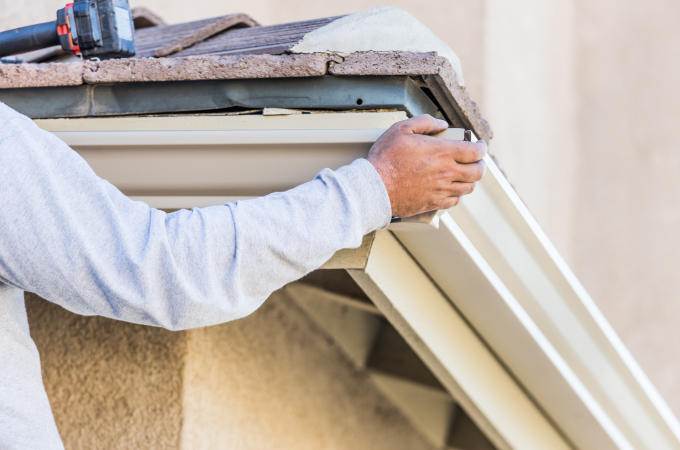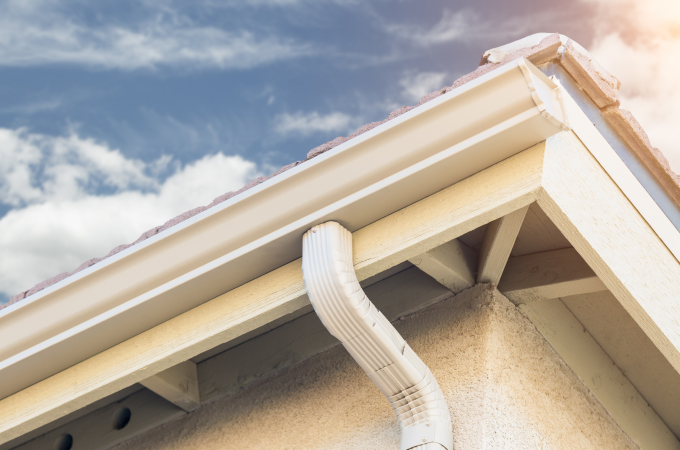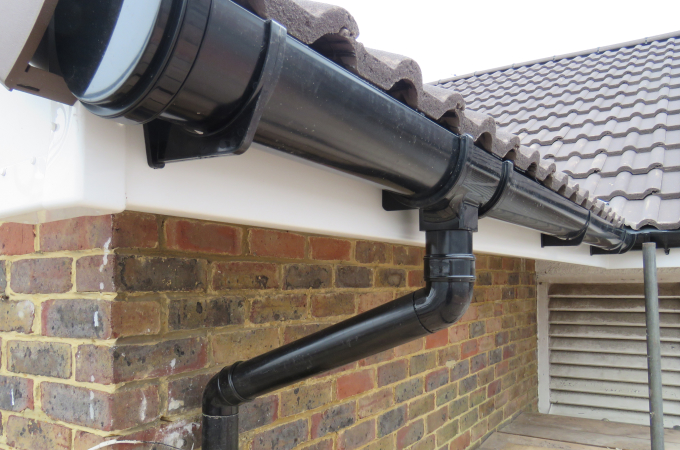A downspout is the vertical section attached to a gutter, typically found on the corner of a home or building. A downspout is a great addition to any drainage solutions system, as it helps channel water away from your home into the dry well, storm drain or other underground drainage system surrounding your home. They help to manage roof runoff, ultimately preventing leaks, flooding, and other damage that comes with drainage problems. Before you buy your new downspouts, take the time to check out the following guide to learn more about your downspout drainage options.
Why Invest in Gutter Downspouts?
Downspouts complement existing drainage systems by helping to funnel water flow from roofs, gutters, and drain pipes away from a home’s foundation walls. For areas that see heavy rain, they are especially helpful in handling excess stormwater, ultimately preventing water damage and other problems that arise with drainage issues.
Different Downspout Drainage Options
Homeowners have a variety of options to consider when thinking about how they’d ultimately like to drain rainwater away from their homes.
Pop-up Emitter
Pop-up emitters are an inexpensive downspout drain option. They are small, circular devices that connect to a downspout by a flexible hose. They are placed a few feet away from a home’s foundation, and the flexible hose is run through a trench and connected to the emitter.
During rainstorms, water is funneled off the roof, through the downspout, and through the flexible hose to the emitter. The emitter then disperses the water over a large area, avoiding water damage to your home’s foundation, as well as erosion and other landscaping damage. Another plus– emitters only open when enough water pressure builds up, so the rocks, leaves, and sticks that clog normal drains are not an issue.
Rain Barrel or Rain Garden
For homeowners with a green thumb (or general eco-consciousness), a rain barrel or rain garden can be a great downspout drain option.
To create a rain barrel downspout drain, homeowners can install downspout diverters that connect directly to rain barrels. During rainstorms, water from your roof is then deposited directly into the barrel, giving you a great water resource for watering your plants or lawn.
Rain gardens are also a great option for garden enthusiasts. A rain garden consists of native shrubs and flowers planted in a small depression or natural slope. During rainstorms, these gardens soak in much of the rainwater runoff from roofs, patios, and landscaping, preventing excess water from causing damage. They are also great for removing chemicals from runoff, controlling mosquito populations, and generally bettering the environment.
Sump Pump
While not necessarily a downspout drain, a sump pump is another drainage option for funneling water away from your home’s foundation to prevent water damage and flooding.
Essentially– a sump pump is installed in a small pit or crawl space at the lowest point of your house. When groundwater starts to accumulate around your house, it begins to funnel through exterior and interior drain pipes into the sump basin. When enough water accumulates in the basin, water is channeled through a discharge pipe and led away from your home’s foundation.
What About Rain Chains?
Rain Chains are a popular alternative to downspouts in many areas. A rain chain will guide water from the horizontal gutter down into chains or cups that end in a decorative container or drainage pipe. Though rain chains do not move water as quickly as oversized downspouts, they certainly do move more water than you may think. We provide numerous options, including cup style, link style, and themed rain chains, and you can also buy a wide variety of accessories for installation and use.
Are Downspouts Enough for Your Needs?
Downspouts come in various sizes in order to funnel large amounts of water runoff away from your roof and off your property. There are some cases, however, when rainfall in an area is so heavy that downspouts cannot do the job alone. In these instances, you will need to take additional measures. Installing a downspout extension or additional drain lines will allow water to flow more smoothly and quickly.
As a general rule of thumb, 3″ downspouts carry 600 square feet of room area, 4″ downspouts carry 1200 square feet of roof area, and 5″ downspouts carry 2000 square feet of roof area.
Once you have determined the shape and size you need, you can also choose your material. There are numerous choices that range from aluminum, stainless steel, and copper. You can even find decorative downspouts that truly make a statement and give your home amazing curb appeal. Options include the following:
- Plain Round Downspouts in 3”, 4”, 5”, and 6” sizes.
- Round Corrugated Downspouts also in 3”, 4”, 5”, and 6” sizes.
- Rectangular Downspouts in 2×3”, 3×4”, and 4×5” sizes.
- Spiral Downspouts in a thick or thin 4” size.
What to Do About Clogged Downspouts
The biggest problem homeowners tend to experience with downspouts is clogging due to leaves, twigs, and other debris entering the gutter system from above. When the clog gets large enough, the rain cannot flow through the downspout, which causes it to back up and spill over the edge of the gutter. It’s typically a simple task to push the debris through, and you can even remove the downspout for easier cleaning. However, installing a gutter guard is the best way to prevent clogs, and reduce gutter maintenance for good.
Your Trusted Partner in Gutter Systems, Gutter Machines, Downspouts, and Accessories
GutterSupply.com provides homeowners and contractors alike with all the products, accessories, and even machines they need to ensure their downspouts look amazing and function appropriately. We have a wide range of downspouts, drain pipes, and more, all available in materials from PVC to aluminum, zinc, and copper. We even carry downspout accessories including downspout extensions, splash blocks, tile adapters, cleanouts, funnels and diverters.
By making sure your downspouts are in good repair, you can prevent damage to your landscaping, basement flooding, foundation cracks, and much, much more. Explore our selection to see which downspouts will work best for your home’s drainage system.
 Contractors
Contractors



